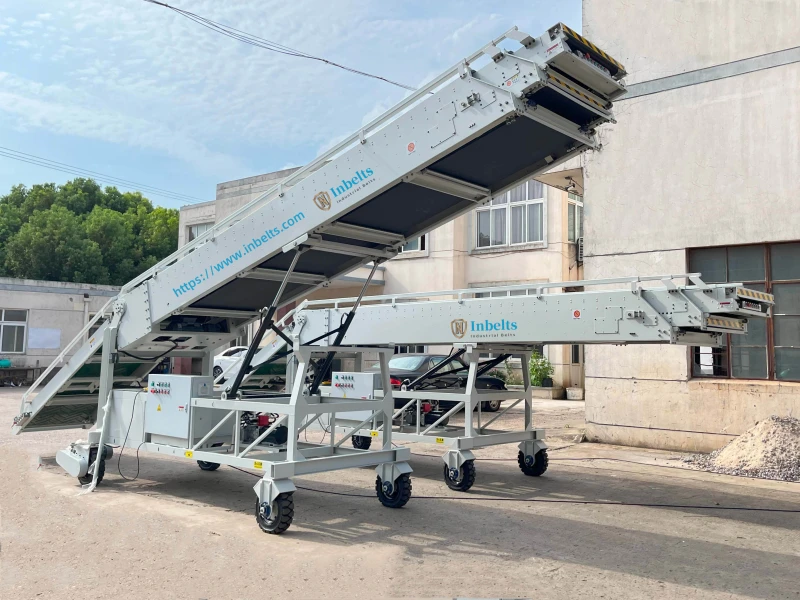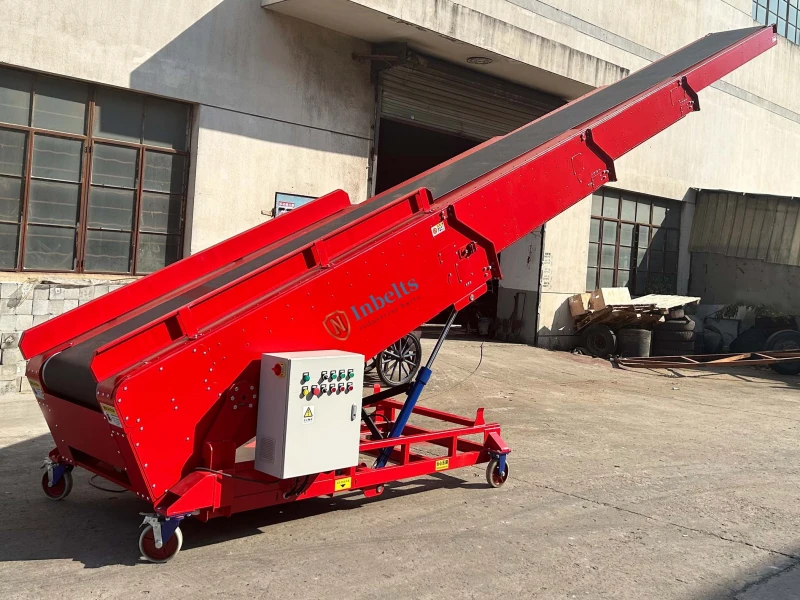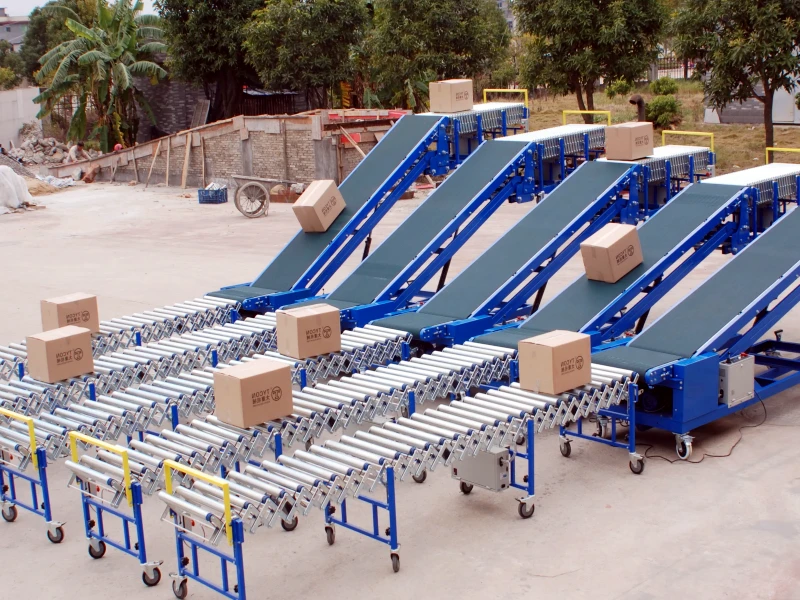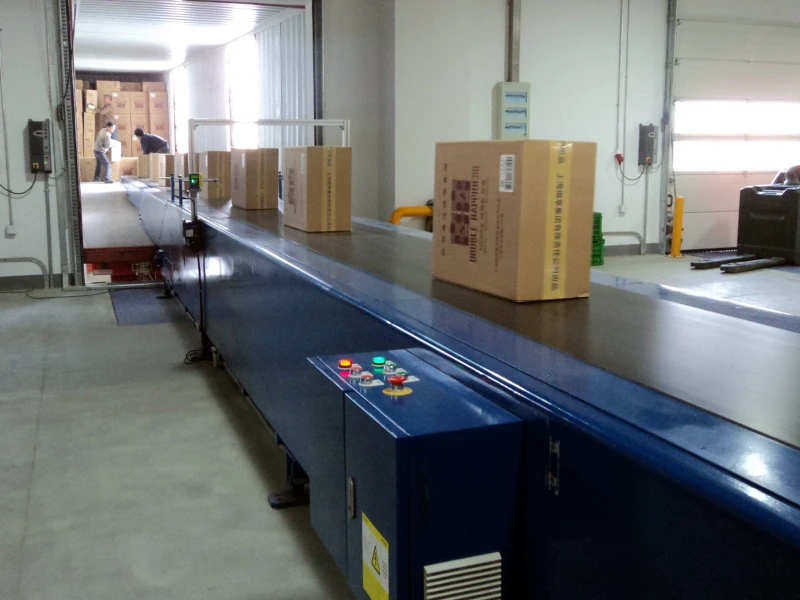
Telescopic Belt Conveyor for Package Loading and Unloading
Telescopic belt conveyors have revolutionized package loading and unloading processes in industries such as logistics, e-commerce, warehousing, and distribution. These conveyors provide a flexible, extendable solution that significantly improves efficiency, reduces manual labor, and enhances workplace safety. Designed to extend directly into trucks, containers, and trailers, telescopic belt conveyors make material handling faster, safer, and more ergonomic. In this guide, we’ll explore the key features, benefits, and applications of telescopic belt conveyors for package loading and unloading.
Telescopic Belt Conveyor for Package Loading Unloading
A telescopic belt conveyor is an extendable conveyor that can be adjusted in length to load and unload packages into trucks, trailers, and containers. The conveyor system consists of several nested sections that retract and extend, allowing it to reach into a vehicle for easy material handling. Telescopic conveyors are often used in logistics and warehousing environments to speed up the loading and unloading process while minimizing the need for manual labor.
Key Features of Telescopic Belt Conveyors
1. Extendable and Retractable Design
The primary feature of a telescopic belt conveyor is its ability to extend and retract. This design allows the conveyor to adjust its length to reach the inside of a truck or container, eliminating gaps between the conveyor and the vehicle. Once the loading or unloading process is complete, the conveyor retracts to save space.
2. Adjustable Height
Telescopic conveyors often come with adjustable height settings, allowing operators to position the conveyor at the optimal height for easy loading or unloading. This feature ensures ergonomic working conditions, reducing the strain on workers and minimizing the risk of injuries.
3. Multi-Section Construction
Most telescopic conveyors are made up of multiple sections that nest within each other. As the conveyor extends, these sections slide out smoothly to provide the required length for reaching into vehicles. When not in use, the sections retract, making the conveyor compact and space-efficient.
4. Powered Belt
Telescopic belt conveyors are powered by motors that drive the belt to move packages along the conveyor. This motorized system allows for the continuous, automated movement of goods, reducing the need for manual handling and increasing the speed of the loading and unloading process.
5. Reversible Operation
Many telescopic conveyors have reversible belt operation, enabling them to move packages in both directions. This feature is useful for both loading and unloading applications, allowing operators to quickly switch between inbound and outbound processes.
6. Safety Features
To ensure safe operation, telescopic conveyors are equipped with safety features such as emergency stop buttons, safety guards, and sensors that detect obstructions on the belt. These features help prevent accidents and protect workers during operation.
7. Mobility and Portability
Telescopic belt conveyors are typically mounted on wheels or casters, allowing for easy mobility around the loading dock or warehouse. This portability makes it simple to move the conveyor between different loading bays or positions, enhancing flexibility in dynamic working environments.

LC Series Telescopic Belt Conveyor for Package Loading Unloading
Benefits of Using Telescopic Belt Conveyors for Package Loading and Unloading
1. Increased Efficiency and Speed
One of the primary benefits of telescopic belt conveyors is the significant increase in efficiency they bring to loading and unloading operations. The extendable design allows workers to transport packages directly into or out of trucks, trailers, or containers, reducing the time and effort required for manual handling. This streamlined process speeds up the overall workflow, improving productivity.
2. Reduced Labor Costs
By automating much of the package loading and unloading process, telescopic conveyors reduce the need for manual labor. Fewer workers are needed to move packages, which not only lowers labor costs but also frees up personnel to focus on other critical tasks.
3. Enhanced Workplace Safety
Manual loading and unloading of packages can lead to injuries, particularly from repetitive lifting, bending, or twisting. Telescopic conveyors minimize these risks by reducing the amount of manual handling required. The adjustable height and powered belt also allow for more ergonomic working conditions, reducing the risk of musculoskeletal injuries.
4. Improved Package Handling
Telescopic conveyors provide a consistent, gentle movement of packages, reducing the risk of damage during loading and unloading. The conveyor ensures that packages are handled with care, maintaining product integrity and reducing the potential for costly damage or returns.
5. Versatility and Flexibility
Telescopic belt conveyors are highly versatile and can handle a wide range of package sizes and weights. Whether you're dealing with small parcels or large boxes, the conveyor can be adjusted to suit the specific requirements of your operation. This flexibility makes it ideal for use in various industries, including logistics, retail, e-commerce, and manufacturing.
6. Space Optimization
When not in use, telescopic belt conveyors retract into a compact size, saving valuable floor space. This space-saving feature is especially useful in busy warehouses or distribution centers where space is limited, allowing businesses to optimize their storage and work areas.

Truck Loading Unloading Conveyor with Flexible Roller Conveyor System
Applications of Telescopic Belt Conveyors
1. Logistics and Distribution Centers
In logistics and distribution centers, telescopic belt conveyors are essential for efficiently loading and unloading packages from trucks and containers. These conveyors speed up the processing of goods, helping companies meet tight delivery schedules and handle high volumes of shipments.
2. E-Commerce Fulfillment
With the rapid growth of e-commerce, fulfillment centers face increasing pressure to process orders quickly and accurately. Telescopic belt conveyors streamline the handling of packages, ensuring that orders are loaded and unloaded efficiently for on-time delivery.
3. Warehousing
In warehousing operations, telescopic belt conveyors are used to transport goods between storage areas and trucks or shipping containers. They reduce the need for manual handling, making it easier to move large volumes of goods and improving overall warehouse efficiency.
4. Parcel and Courier Services
Parcel and courier companies rely on telescopic conveyors to handle packages during the shipping and receiving process. By automating the loading and unloading of delivery vehicles, these conveyors help ensure fast, reliable service and reduce turnaround times at depots and hubs.
5. Manufacturing
In manufacturing facilities, telescopic belt conveyors are used to move finished products from production lines to trucks or containers for shipment. They allow for efficient loading and unloading of goods, ensuring that products reach their destinations on time and in good condition.

FTBC Series Telescopic Belt Conveyor for Package Loading Unloading
Key Considerations When Choosing a Telescopic Belt Conveyor
1. Conveyor Length and Extension Range
The length and extension range of the telescopic belt conveyor are important factors to consider. Ensure that the conveyor can fully extend to reach the far end of the truck, trailer, or container, while also being able to retract when not in use.
2. Weight Capacity
Check the weight capacity of the conveyor to ensure it can handle the types of packages being transported. Heavy-duty conveyors may be required for operations dealing with large or heavy parcels.
3. Belt Speed and Power
Consider the belt speed and motor power of the conveyor, as these will affect how quickly packages can be moved. High-speed conveyors are ideal for operations that require fast loading and unloading, while lower speeds may be sufficient for smaller-scale operations.
4. Safety Features
Ensure the telescopic conveyor is equipped with safety features such as emergency stop buttons, sensors, and safety guards. These features are crucial for protecting workers and preventing accidents during operation.
5. Adjustability and Mobility
Look for conveyors with adjustable height settings and portability features like wheels or casters. These features enhance the flexibility of the conveyor, making it easier to move between loading docks or adjust to different truck heights.
Telescopic belt conveyors offer an efficient and flexible solution for package loading and unloading in a wide range of industries. By automating material handling, these conveyors improve productivity, reduce labor costs, and enhance workplace safety. Whether used in logistics, e-commerce, warehousing, or manufacturing, telescopic belt conveyors streamline the movement of packages, making them an essential tool for businesses looking to optimize their operations. Understanding the key features, benefits, and applications of these conveyors will help you select the right system to meet your specific needs and improve overall efficiency.


Leave Me Your Requirement!